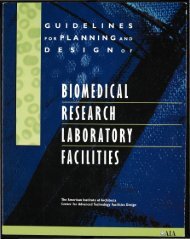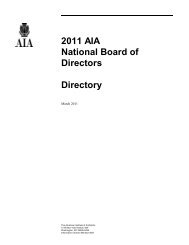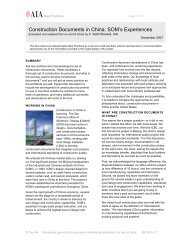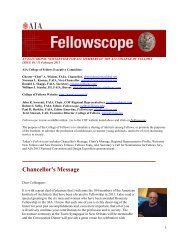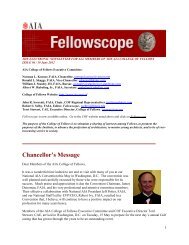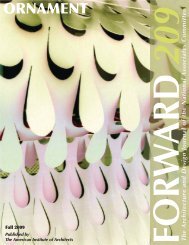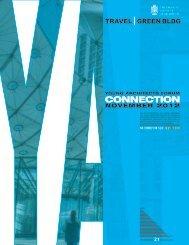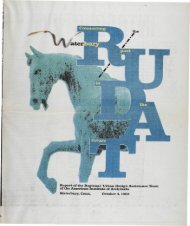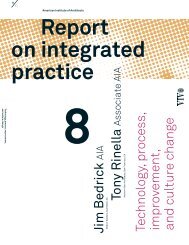Summer 2007 - American Institute of Architects
Summer 2007 - American Institute of Architects
Summer 2007 - American Institute of Architects
You also want an ePaper? Increase the reach of your titles
YUMPU automatically turns print PDFs into web optimized ePapers that Google loves.
<strong>Summer</strong> <strong>2007</strong><br />
Committee on Design eNewsletter | |<br />
Redlines<br />
<strong>2007</strong> Conference Chair Michael Ross, FAIA, and<br />
Miami Conference Chair Roberto Espejo, AIA<br />
A Note from the Chair<br />
With this issue we inaugurate re: Design,<br />
the COD eNewsletter. It is part <strong>of</strong> our<br />
attempt to make the COD’s activities<br />
more valuable to more AIA members. We<br />
are especially grateful to Ann Gray, FAIA,<br />
<strong>of</strong> Balcony Press for sponsoring this<br />
issue. We hope you enjoy this newsletter<br />
and welcome your comments at<br />
elCommuniCODo@mmense.com.<br />
This year we are considering “The<br />
Rejuvenation <strong>of</strong> <strong>American</strong> Cities on the<br />
Water.” Our first conference exploring<br />
this theme was in Miami in April, and we<br />
want to thank Roberto Espejo, AIA, and<br />
all <strong>of</strong> our hosts in Miami for their efforts.<br />
The fall conference, On the Waterfront,<br />
will be held September 27-30<br />
in Minneapolis. Both cities experienced a<br />
boom in the early 20th century and a<br />
decline in the later part <strong>of</strong> the century,<br />
followed by a total renaissance at the<br />
start <strong>of</strong> the 21st century. Come<br />
experience the unique architectural expressions <strong>of</strong> the Minneapolis design community.<br />
—Michael Franklin Ross, FAIA, <strong>2007</strong> COD Chair<br />
Calendar<br />
AIA COD Fall <strong>2007</strong> Conference: On the Waterfront: Renaissance Through<br />
Design Excellence<br />
September 27–30, <strong>2007</strong><br />
Minneapolis<br />
Register online l Conference information<br />
AIA COD Spring 2008 Conference<br />
April 3–6, 2008<br />
Detroit and Cranbrook<br />
AIA COD Fall 2008 Conference<br />
August 31–September 3, 2008 (note new dates)<br />
Copenhagen, Denmark<br />
Designations<br />
News for and about the Committee on Design<br />
2008 AIA COD Design Ideas Competition: Living—out <strong>of</strong> the car . . .<br />
A challenge to resolve infrastructure, architecture, and product design through ideas<br />
<strong>of</strong> combining an energy system, garage, and automobile. Look for the entry invitation<br />
this fall.<br />
AIA Honor Awards in San Antonio<br />
http://info.aia.org/nwsltr_cod.cfm?pagename=cod_nwsltr_current[12/7/2010 9:11:09 AM]<br />
<strong>Summer</strong> <strong>2007</strong><br />
This issue is generously<br />
sponsored by Balcony Press<br />
to celebrate its new<br />
magazine FORM.<br />
In This Issue<br />
Preserving Modern<br />
Architecture<br />
AIA COD <strong>2007</strong> Design<br />
Ideas Competition<br />
April <strong>2007</strong>: The<br />
Rejuvenation <strong>of</strong> <strong>American</strong><br />
Cities on the Water
<strong>Summer</strong> <strong>2007</strong><br />
As a part <strong>of</strong> its commitment to excellent design, the COD established a process to<br />
seek and support qualified nominees for certain AIA honors. This year the following<br />
successful COD-nominated candidates were celebrated at the AIA <strong>2007</strong> National<br />
Convention in San Antonio:<br />
Architecture Firm Award: Leers Weinzapfel Associates, Boston<br />
Twenty-five Year Award: Vietnam Veterans Memorial, designed by Maya Lin with<br />
Cooper Lecky <strong>Architects</strong><br />
Honorary AIA Fellows<br />
David Chipperfield, Hon. FAIA, United Kingdom<br />
Emilio Ambasz, Hon. FAIA, Italy<br />
Francine Houben, Hon. FAIA, The Netherlands<br />
Dominique Perrault, Hon. FAIA, France<br />
Eduardo Souto de Moura, Hon. FAIA, Portugal<br />
<strong>Institute</strong> Honors for Collaborative Achievement<br />
Bryan Bell, advocate for architecture for indigent communities<br />
Francis D.K. Ching, author<br />
The Directory <strong>of</strong> African <strong>American</strong> <strong>Architects</strong><br />
Harvard Design Magazine<br />
Thomas S. Hines, architectural historian and educator<br />
Public Architecture, San Francisco<br />
Witold Rybczynski, Hon. FAIA, author<br />
For further information about these and other award winners, see the AIA National<br />
Honor Awards Web page.<br />
Preserving Modern Architecture<br />
As <strong>American</strong> Modern architecture matures, more and more <strong>of</strong> it faces the possibility<br />
<strong>of</strong> demolition to make way for progress or insensitive modification. The AIA<br />
Committee on Design wants to help preserve those works that may have more design<br />
value than historic value.<br />
Read the full article<br />
Fountain <strong>of</strong> Use: Winners <strong>of</strong> the AIA COD <strong>2007</strong> Design Ideas Competition<br />
by James Bowen, AIA<br />
The downtown Miami waterfront provided the background for exploring the<br />
meaningful use <strong>of</strong> water as a component <strong>of</strong> urban planning—thus the title <strong>of</strong> the<br />
<strong>2007</strong> COD International Design Ideas Competition, "Fountain <strong>of</strong> Use." The competition<br />
jury announced two winning entries on April 14 following a reception at the<br />
Wolfsonian Museum in Miami:La Nueva Costanera de Miami (The New Miami<br />
Waterfront), designed by Mike Mense, FAIA, with Ron Andersen and PALM (Planting in<br />
the Aquifer for a Livable Miami), designed by Wendy Evans Joseph, FAIA, with with<br />
Jonathan Lee and Farzana Gandhi.<br />
Read the full article<br />
COD Meets in Miami for the<br />
Rejuvenation <strong>of</strong> <strong>American</strong> Cities<br />
on the Water<br />
by Eduardo Quintero<br />
The <strong>2007</strong> AIA COD conference in<br />
Miami, held April 12–15, <strong>2007</strong>, was<br />
enthusiastic, diverse, provocative,<br />
and a whole lot <strong>of</strong> fun. The<br />
Rejuvenation <strong>of</strong> <strong>American</strong> Cities on<br />
the Water, was carefully planned to<br />
explore the exciting developments<br />
along Miami’s several waterfronts."<br />
Most <strong>of</strong> the talks and tours focused<br />
on this exciting, already commenced<br />
transformation, which promises to<br />
secure Miami’s role as the gateway<br />
to the Americas.<br />
Conference attendees enjoyed a rich and<br />
insightful walking tour <strong>of</strong> Miami Beach,<br />
highlighting its Art Deco architecture.<br />
Population and geography could both significantly drive Miami’s architectural<br />
resolution. Newly termed during our conference as "geo-fabulous,” this tropically hot<br />
topic <strong>of</strong> a city was explored by the attendees and rediscovered as possibly one <strong>of</strong> the<br />
most important emerging cities in the world in terms <strong>of</strong> social infrastructure and<br />
architectural growth.<br />
Read the full report<br />
http://info.aia.org/nwsltr_cod.cfm?pagename=cod_nwsltr_current[12/7/2010 9:11:09 AM]
<strong>Summer</strong> <strong>2007</strong><br />
Do You Remember?<br />
Peter Lizon, FAIA, has agreed to prepare a history <strong>of</strong> the COD. You can help. What is<br />
the most memorable presentation you remember from past COD events? Who made<br />
the presentation, when, and where? What made it memorable? Please send your<br />
answers to eLcommuniCODo@mmense.com.<br />
Links<br />
World Architecture News<br />
Sarasota Architectural Foundation<br />
Design Journal<br />
BuildingGreen<br />
DOCOMOMO<br />
Imagine Miami<br />
Houston Mod<br />
AIA Online Publications<br />
Site Map | Privacy | Contact<br />
Us<br />
http://info.aia.org/nwsltr_cod.cfm?pagename=cod_nwsltr_current[12/7/2010 9:11:09 AM]<br />
©2009 The <strong>American</strong> <strong>Institute</strong> <strong>of</strong> <strong>Architects</strong>, All Rights Reserved.<br />
<br />
<br />
<br />
function showHide(targetName) {<br />
if( document.getElementById ) { // NS6+<br />
target = document.getElementById(targetName);<br />
} else if( document.all ) { // IE4+<br />
target = document.all[targetName];<br />
}<br />
if( target ) {<br />
if( target.style.display == "none" ) {<br />
target.style.display = "inline";<br />
} else {<br />
target.style.display = "none";<br />
}<br />
}<br />
}<br />
<br />
The web site you are accessing has experienced<br />
an unexpected error.Please contact the website administrator. <br />
<br />
<br />
<br />
The following<br />
information is meant for the website developer for debugging purposes. <br />
<br />
<br />
Error Occurred<br />
While Processing Request <br />
<br />
<br />
<br />
<br />
<br />
<br />
Variable GETLINK is undefined.<br />
<br />
<br />
<br />
<br />
<br />
<br />
Resources:<br />
<br />
Enable Robust Exception Information to provide greater detail about the source <strong>of</strong> errors. In<br />
the Administrator, click Debugging & Logging > Debugging Settings, and select the Robust<br />
Exception Information option.<br />
Check the ColdFusion<br />
documentation to verify that you are using the correct syntax.
Preserving Modern Architecture<br />
Committee on Design eNewsletter | |<br />
Preserving Modern Architecture<br />
As <strong>American</strong> Modern architecture matures, more and more <strong>of</strong> it<br />
faces the possibility <strong>of</strong> demolition to make way for progress or<br />
insensitive modification. The COD wants to help preserve those<br />
works that may have more design value than historic value.<br />
<strong>American</strong>s are all for saving architecture that’s older than your<br />
great-grandmother and looks like it. Newer architecture, that might<br />
remind you more <strong>of</strong> your punk cousin, doesn’t receive the same<br />
affection. Probably every generation has had a similar experience,<br />
but ours feels unique because <strong>of</strong> the apparently drastic divide<br />
between 2,000 years <strong>of</strong> architecture, detailed in a historical manner,<br />
and the last hundred years or so when much <strong>of</strong> that detail was<br />
stripped away.<br />
Architecture is different from arts and crafts because older buildings<br />
can’t be moved (well, almost never) to make room for the new. It’s<br />
much easier to preserve vintage arts and crafts objects. For<br />
buildings that’s much harder, and <strong>of</strong>ten harmful to the surrounding<br />
environment. Adaptive reuse may be impossible to accomplish<br />
without destroying the building’s character.<br />
Nonetheless, why is it that history seems a more legitimate reason<br />
to preserve than architectural value? We don’t burn Aristotle’s<br />
books, even though most <strong>of</strong> his truths are thoroughly discredited.<br />
It’s our job as architects to make sure the public knows what’s at<br />
stake when it proposes to tear down a fine work <strong>of</strong> architecture, or<br />
even the work <strong>of</strong> a fine architect. It’s our job as architects to know<br />
about the important work in our community and to react when that<br />
work is threatened.<br />
In Baltimore, the Morris A.<br />
Mechanic Theater, by John M.<br />
Johansen, FAIA, shown at the left,<br />
is not immediately threatened, but<br />
some local architects are seeking<br />
landmark status for it in hopes <strong>of</strong><br />
avoiding such a threat in the<br />
future. Said Michael Murphy, AIA, a<br />
member <strong>of</strong> Baltimore’s Commission<br />
for Historical and Architectural<br />
Preservation, "I think there is a national epidemic going on that<br />
requires concerted action before much <strong>of</strong> the best work <strong>of</strong> the '60s<br />
and '70s is lost. My message to the AIA Committee on Design is<br />
'Help!'”<br />
Paul Rudolph’s Riverview High School in Sarasota, Fla., is<br />
http://info.aia.org/nwsltr_cod.cfm?pagename=cod_a_<strong>2007</strong>08_mod_arc_prsv[12/7/2010 9:16:04 AM]<br />
<strong>Summer</strong> <strong>2007</strong><br />
This issue is generously<br />
sponsored by Balcony Press<br />
to celebrate its new<br />
magazine FORM.<br />
In This Issue<br />
Preserving Modern<br />
Architecture<br />
AIA COD <strong>2007</strong> Design<br />
Ideas Competition<br />
April <strong>2007</strong>: The<br />
Rejuvenation <strong>of</strong> <strong>American</strong><br />
Cities on the Water
Preserving Modern Architecture<br />
threatened with demolition to make room for a parking lot. The<br />
Sarasota Architectural Foundation has won a reprieve until March<br />
2008 to find a viable design and financial alternative that meets the<br />
property owner’s objectives and preserves the work. They are<br />
presently advertising a competition to find that alternative. Click<br />
here for more Information on the competition. Statements <strong>of</strong><br />
qualifications are due September 14, <strong>2007</strong>.<br />
The organization Houston Mod is active in the appreciation and<br />
preservation <strong>of</strong> Modern design in Houston and throughout Texas.<br />
The COD sees the stewardship <strong>of</strong> Modern architecture as an<br />
important part <strong>of</strong> its mission. If you know <strong>of</strong> Modern work that is<br />
threatened, please contact eLcommuniCODo@mmense.com. The<br />
AIA HRC Historic Structures Advocacy Team is also interested in<br />
these issues.<br />
Site Map | Privacy | Contact<br />
Us<br />
http://info.aia.org/nwsltr_cod.cfm?pagename=cod_a_<strong>2007</strong>08_mod_arc_prsv[12/7/2010 9:16:04 AM]<br />
©2009 The <strong>American</strong> <strong>Institute</strong> <strong>of</strong> <strong>Architects</strong>, All Rights Reserved.<br />
<br />
<br />
<br />
function showHide(targetName) {<br />
if( document.getElementById ) { // NS6+<br />
target = document.getElementById(targetName);<br />
} else if( document.all ) { // IE4+<br />
target = document.all[targetName];<br />
}<br />
if( target ) {<br />
if( target.style.display == "none" ) {<br />
target.style.display = "inline";<br />
} else {<br />
target.style.display = "none";<br />
}<br />
}<br />
}<br />
<br />
The web site you are accessing has experienced<br />
an unexpected error.Please contact the website administrator. <br />
<br />
<br />
<br />
The following<br />
information is meant for the website developer for debugging purposes. <br />
<br />
<br />
Error Occurred<br />
While Processing Request <br />
<br />
<br />
<br />
<br />
<br />
<br />
Variable GETLINK is undefined.<br />
<br />
<br />
<br />
<br />
<br />
<br />
Resources:<br />
<br />
Enable Robust Exception Information to provide greater detail about the source <strong>of</strong> errors. In<br />
the Administrator, click Debugging & Logging > Debugging Settings, and select the Robust<br />
Exception Information option.<br />
Check the ColdFusion
AIA COD <strong>2007</strong> Design Ideas Competition<br />
Committee on Design eNewsletter | |<br />
AIA COD <strong>2007</strong> Design Ideas Competition<br />
Fountain <strong>of</strong> Use Winners<br />
James Bowen, AIA<br />
Fountain <strong>of</strong> Use, the <strong>2007</strong> COD International Design Ideas<br />
Competition, announced two winning entries on April 14 following a<br />
reception at the Wolfsonian Museum, Miami Beach. Mike Mense,<br />
FAIA, with Ron Andersen and Wendy Joseph Evans, FAIA, with<br />
Jonathan Lee and Farzana Gandhi were recognized for their ideas<br />
illustrating the responsible use <strong>of</strong> water within a developing urban<br />
waterfront. The competition site along the downtown Miami<br />
waterfront provided the background for exploring the meaningful<br />
use <strong>of</strong> water as a component <strong>of</strong> urban planning.<br />
The competition jurors were Julie Sinclair Eakin, executive editor <strong>of</strong><br />
CITE: The Architecture and Design Review <strong>of</strong> Houston; Raymond<br />
Jungles, FASLA, a Miami landscape architect; Peter Magyar,<br />
founding director and pr<strong>of</strong>essor <strong>of</strong> the Florida Atlantic University<br />
School <strong>of</strong> Architecture; and Chad Oppenheim, AIA, founding<br />
principal and lead designer at Oppenheim Architecture + Design,<br />
Miami.<br />
Mense’s submission, titled La Nueva Costanera de Miami (The New<br />
Miami Waterfront), explored a myriad <strong>of</strong> ideas organized along a<br />
canal that displaced Biscayne Boulevard. The jury commented,<br />
“Exuberance and wit characterize the Mywater concept, and it<br />
ultimately proved irresistible among a few other entries that also<br />
made a canal <strong>of</strong> Biscayne Boulevard. The vision proposed here is<br />
one we would actually enjoy experiencing—a return <strong>of</strong> wildlife to its<br />
habitat, for instance, together with the recognition <strong>of</strong> and respect<br />
for the site’s urban bones.”<br />
Evans's very different approach created an idea <strong>of</strong> a desalination<br />
system devised as a series <strong>of</strong> palm-like elements, programmed to<br />
clarify the aquifer below the site and Biscayne Bay. The jury<br />
commented, “Notably, PALM (Planting in the Aquifer for a Livable<br />
Miami) was the only project that specifically mentioned<br />
sustainability in its description. The designers’ original approach to<br />
thinking about the city’s (and specifically this site’s) future won us<br />
over. They identified a genuine need, and in proposing this<br />
desalinization initiative, interpreted the competition’s program<br />
challenges in a meaningful way. The technology is appealing in its<br />
simplicity—we felt that some version <strong>of</strong> the idea could actually be<br />
made to work.”<br />
James Bowen, AIA, was this year's COD competition coordinator.<br />
Site Map | Privacy | Contact<br />
Us<br />
http://info.aia.org/nwsltr_cod.cfm?pagename=cod_a_<strong>2007</strong>08_fou_win[12/7/2010 9:16:20 AM]<br />
<strong>Summer</strong> <strong>2007</strong><br />
This issue is generously<br />
sponsored by Balcony Press<br />
to celebrate its new<br />
magazine FORM.<br />
In This Issue<br />
Preserving Modern<br />
Architecture<br />
AIA COD <strong>2007</strong> Design<br />
Ideas Competition<br />
April <strong>2007</strong>: The<br />
Rejuvenation <strong>of</strong> <strong>American</strong><br />
Cities on the Water<br />
©2009 The <strong>American</strong> <strong>Institute</strong> <strong>of</strong> <strong>Architects</strong>, All Rights Reserved.
April <strong>2007</strong>: The Rejuvenation <strong>of</strong> <strong>American</strong> Cities on the Water<br />
Committee on Design eNewsletter | |<br />
April <strong>2007</strong>: The Rejuvenation <strong>of</strong> <strong>American</strong> Cities on the Water<br />
April 12–15, <strong>2007</strong><br />
The Standard Hotel<br />
Miami<br />
The <strong>2007</strong> AIA COD conference in Miami was enthusiastic, diverse, provocative, and a whole lot <strong>of</strong> fun. The<br />
marathon <strong>of</strong> organized events carried the zeitgeist <strong>of</strong> Miami, full <strong>of</strong> optimism, excitement, and progress<br />
while also discussing Miami’s current challenges. This energy was apparent in the dedication <strong>of</strong> the several<br />
tour guides who donated their services, the creative range <strong>of</strong> restaurant choices and diverse dishes, and<br />
most, by the incredible development in downtown Miami.<br />
The conference, The Rejuvenation <strong>of</strong> <strong>American</strong> Cities on the Water, was carefully planned to explore the<br />
exciting developments along Miami’s several waterfronts. The physical indication <strong>of</strong> this transformation is<br />
the number <strong>of</strong> condominium towers and construction cranes that overpopulate the skyline. But the catalyst<br />
<strong>of</strong> this development is found closer to the ground and is intended for the benefit <strong>of</strong> all. The private and<br />
public sector have teamed up to transform the city from “Tropi-cool” to “Tropi-cultural” through the<br />
marketing and construction <strong>of</strong> various art and culture facilities nestled among the various city parks and<br />
urban corridors. Most <strong>of</strong> the talks and tours focused on this exciting, already commenced transformation,<br />
which promises to secure Miami’s role as the gateway to the Americas. The pr<strong>of</strong>ound four-day discourse<br />
among panelists and participants illustrated that this “Capital City <strong>of</strong> the Americas” also has its serious<br />
pressure points. In addition to Miami’s population diversity, the group experienced first hand the<br />
metropolis’ range <strong>of</strong> geographical conditions, including the Florida Keys to the south, the Everglades to the<br />
west, Biscayne Bay, the Miami River, and the Atlantic Ocean. Population and geography could both<br />
significantly drive Miami’s architectural resolution. Newly termed during our conference as “Geo-Fabulous,”<br />
this tropically hot topic <strong>of</strong> a city was explored by the attendees and rediscovered as possibly one <strong>of</strong> the<br />
most important emerging cities in the world in terms <strong>of</strong> social infrastructure and architectural growth.<br />
The four-day conference began on Thursday with a warm welcome from Miami’s Mayor Manny Diaz. First<br />
elected in 2001, and then reelected to a second term in 2005, Mayor Diaz has led Miami towards a<br />
visionary rebirth <strong>of</strong> prosperity and opportunity. A torrential morning rain had become a beautiful afternoon<br />
when the mayor greeted the AIA conference on his private terrace at the Miami City Hall. This building is a<br />
former Pan-<strong>American</strong> Airways terminal from which “snow birds” shuttled to the Keys and Cuba in the<br />
1920s and ‘30s.<br />
Overlooking the bay and the Coconut Grove Coral Reef Yacht Club, the mayor pointed out the dynamic<br />
changes to the city in his talk, The Past, Present, and Future <strong>of</strong> Miami. In just a few minutes, the mayor<br />
accomplished the difficult task <strong>of</strong> laying out his gigantic plans for the city, which include the complete<br />
overhaul <strong>of</strong> the City’s zoning code, named “Miami 21”; the creation <strong>of</strong> an art and culture campus on<br />
Biscayne Bay; and an ambitious sustainability program to make Miami responsibly “green.” The mayor was<br />
accompanied by Elizabeth Plater-Zyberk, dean <strong>of</strong> architecture at the University <strong>of</strong> Miami. Plater-Zyberk, as<br />
a partner <strong>of</strong> the <strong>of</strong>fice <strong>of</strong> Duany Plater-Zyberk (DPZ), is responsible for the Miami 21 program. This<br />
program’s goal is to revise the city’s zoning codes and regulations so as to support higher density and<br />
greater sustainability. At the end <strong>of</strong> the ceremony, Michael Ross, FAIA, presented a proclamation from the<br />
AIA COD to Mayor Diaz, recognizing his continuous political commitment to Miami’s architecture and<br />
design.<br />
To take advantage <strong>of</strong> the spectacular sunset from a water’s view perspective, the conference mobilized to<br />
Bayside Marketplace to board the Nautical Queen for a boat tour <strong>of</strong> Miami’s coast, led by history pr<strong>of</strong>essor<br />
http://info.aia.org/nwsltr_cod.cfm?pagename=cod%5Fcrp%5F<strong>2007</strong>04%5FMiami[12/7/2010 9:17:52 AM]<br />
<strong>Summer</strong> <strong>2007</strong><br />
This issue is generously<br />
sponsored by Balcony Press<br />
to celebrate its new<br />
magazine FORM.<br />
In This Issue<br />
Preserving Modern<br />
Architecture<br />
AIA COD <strong>2007</strong> Design<br />
Ideas Competition<br />
April <strong>2007</strong>: The<br />
Rejuvenation <strong>of</strong> <strong>American</strong><br />
Cities on the Water
April <strong>2007</strong>: The Rejuvenation <strong>of</strong> <strong>American</strong> Cities on the Water<br />
Paul George. Aboard this spacious boat, the conference attendees were privileged with panoramic views <strong>of</strong><br />
the Miami area from Biscayne Bay and an inside look on downtown and Brickell Avenue from the Miami<br />
River. Aided by continuous refreshments, George <strong>of</strong>fered an insightful overview <strong>of</strong> the downtown’s history<br />
and today’s urban riverfront renewal. During a short pause between Biscayne Bay and Government Cut,<br />
the attendees were presented with a distant view <strong>of</strong> some <strong>of</strong> the upcoming tour venues, including Ten<br />
Museum Park (TMP), a condominium tour by Oppenheim Studio, and the Carnival Center for the<br />
Performing Arts by Pelli Clarke Pelli <strong>Architects</strong> (PCPA). The boat then took everyone back to the dock at<br />
the conference hotel, The Standard, passing by various man-made islands, where many <strong>of</strong> today’s<br />
celebrities have homes, a tradition that dates back to the days <strong>of</strong> Al Capone.<br />
Friday, the second day <strong>of</strong> the conference, was dedicated to touring some <strong>of</strong> the<br />
most distinguished contemporary construction in Miami. The selected buildings<br />
encompassed the variety <strong>of</strong> typologies going up in the city today. The first stop was<br />
the recently completed Federal Courthouse, by Arquitectonica, in downtown Miami.<br />
Laurinda Spear, a partner in Arquitectonica, led the tour with help from other staff<br />
members, <strong>of</strong>fering an enthusiastic insight into the challenges and satisfactions <strong>of</strong><br />
designing General Services Administration buildings in Miami. The courthouse is<br />
located at the termination point <strong>of</strong> the Miami Dade College main pedestrian walk and<br />
its iconic figure has redefined the downtown area. The building is the home <strong>of</strong> 16<br />
court rooms, individually designed for each judge, and a large number <strong>of</strong> carefully<br />
detailed gathering spaces. The building is fully covered with Italian limestone <strong>of</strong><br />
different tones, laid out in a rhythmic pattern that extends onto the floors and<br />
ceilings as well. Incorporated into the design <strong>of</strong> the courthouse is the work <strong>of</strong> more<br />
than 100 artists. Among them is Maya Lin, recent recipient <strong>of</strong> the AIA Twenty-five<br />
Year Award for the Vietnam Veterans Memorial, who designed the contoured east lawn <strong>of</strong> this building.<br />
The second stop was the residential condominium project TMP, the most prominent<br />
example <strong>of</strong> the new residential towers on Biscayne Bay north <strong>of</strong> downtown. Chad<br />
Oppenheim, codeveloper and architect <strong>of</strong> the building, led the tour. The building<br />
serves as an example <strong>of</strong> the impact architecture can have on the value <strong>of</strong><br />
condominiums, even in a highly commoditized real estate market. TMP broke all<br />
records when it entered the market. In eight days, all units were sold at<br />
unprecedented levels, with prices more than 50 percent higher than those <strong>of</strong><br />
neighboring buildings. This success is partially attributed to Oppenheim’s sensibility<br />
and ability to capture the desired lifestyle in Miami through residential units uniquely<br />
open and connected to the local context. In addition, the building is the setting <strong>of</strong> 18<br />
meticulously designed private pools, its own in-house spa, Clinique La Prairie, streetlevel<br />
restaurants, <strong>of</strong>fices, and retail spaces.<br />
The group next visited the Espirito Santo Building, designed by Kohn Pedersen Fox.<br />
The project manager, Senior Associate Principal Peter Gross and Design Partner in Charge William Louie,<br />
FAIA, led the conference attendees through various spaces <strong>of</strong> this spectacular mixed-use tower. Located<br />
on Brickell Avenue, the building has become an icon in the city due to its unique and inviting carved-out<br />
parabolic west façade. The building houses the <strong>American</strong> headquarters <strong>of</strong> the Portuguese Espirito Santo<br />
Bank and the Conrad Hotel and Residences. Louie explained some <strong>of</strong> the extensive provisions creatively<br />
incorporated in order to withstand the potential floods and hurricanes <strong>of</strong> Miami. The building features a<br />
naturally ventilated atrium with a glass-bottomed pool that serves as a massive skylight for the building<br />
vehicular drop-<strong>of</strong>f below, and a multilevel hotel atrium on the 25th floor with an intricately detailed curtain<br />
wall and louver system that overlooks Biscayne Bay.<br />
The conference then convened for the annual AIA COD business meeting in the historic Freedom Tower on<br />
Biscayne Boulevard. Built in 1920 and formerly known as the Miami News Tower, the Freedom Tower<br />
became a refuge for Cuban immigrants in 1959. It served as a sort <strong>of</strong> Ellis Island and Statue <strong>of</strong> Liberty as<br />
the Immigration and Naturalization Services and Red Cross rented the building for many years and<br />
processed hundreds <strong>of</strong> thousands <strong>of</strong> these immigrants. Building developer David Martin <strong>of</strong> Terra Group<br />
welcomed the group with a brief history <strong>of</strong> the building and his personal association with it. Roberto Espejo<br />
pointed out the creativity <strong>of</strong> BFA seniors from the New World School <strong>of</strong> the Arts, who were enjoying their<br />
first exhibit in the newly renovated gallery space. Attendees then discussed the merits <strong>of</strong> many candidates<br />
for the AIA Gold Medal, the AIA Firm Award, the AIA Twenty-five Year Award, and Honorary Fellowship.<br />
The fourth and final stop was the Carnival Center <strong>of</strong> the Performing<br />
Arts, designed by PCPA. PCPA Senior Associate and local conference<br />
chair Roberto Espejo, leading the tour, passionately described the<br />
urban and acoustical significance <strong>of</strong> the building. The walk-through<br />
started at the Thompson Plaza for the Arts, located between the Ziff<br />
Ballet Opera House and the Knight Concert Hall. With a brick-andmortar<br />
cost <strong>of</strong> around $360 million, the Carnival Center is the largest<br />
private/public partnership in the United States. As an urban design<br />
element, it is the pioneer and catalyst <strong>of</strong> the current wave <strong>of</strong><br />
development in the immediate area. Together with theater planners<br />
http://info.aia.org/nwsltr_cod.cfm?pagename=cod%5Fcrp%5F<strong>2007</strong>04%5FMiami[12/7/2010 9:17:52 AM]
April <strong>2007</strong>: The Rejuvenation <strong>of</strong> <strong>American</strong> Cities on the Water<br />
Fisher Dachs and ARTEC Consultants guiding the acoustics, PCPA designed a 2,500 seat ballet/opera<br />
house with unprecedented theatrical capabilities, including one <strong>of</strong> the largest stages and highest fly l<strong>of</strong>ts in<br />
the United States. On the opposite side <strong>of</strong> Biscayne Boulevard is a 2,200-seat concert hall with infinite<br />
acoustic flexibility and a warm, rich maple interior. This hall features a 128,000-pound movable acoustic<br />
canopy which can lower to adapt to the sound <strong>of</strong> a soloist, for example, or raise to best fit the sound <strong>of</strong> a<br />
large orchestra. In addition, 84 electronically operated doors weighing between five and 12 tons each<br />
surround the hall and can be opened up onto a huge reverberation chamber that can prolong the life <strong>of</strong><br />
sound for up to nine seconds. By the end <strong>of</strong> the tour, it became clear why the building has become an<br />
international destination and a strong testament <strong>of</strong> the city’s commitment to its cultural and artistic<br />
mission.<br />
On Saturday, the third day <strong>of</strong> the conference, the attendees met at the<br />
Miami Art Museum (MAM) to participate in a discussion <strong>of</strong> the<br />
transformation <strong>of</strong> downtown Miami’s Bicentennial Park. The distinguished<br />
panel <strong>of</strong> speakers included Terence Riley, chief curator <strong>of</strong> MAM; Gillian<br />
Thomas, president <strong>of</strong> the Miami Museum <strong>of</strong> Science (MMS); Alex Cooper,<br />
principal <strong>of</strong> Cooper Robertson; Timothy Schmand, <strong>of</strong> the Bay Front Trust;<br />
and Michael Spring, <strong>of</strong> the Miami Dade Cultural Affairs Council. Riley<br />
started by introducing Cooper, who presented the park master plan for<br />
the newly-named Museum Park. Because the master plan includes the<br />
new sites for the MAM and MMS, Riley then continued with a talk that<br />
described the selection process used to choose the architect <strong>of</strong> the new MAM. The finalists included<br />
Mansilla y Tullon, Renzo Piano, Tadao Ando, and Zaha Hadid, among many other internationally renowned<br />
architects. The selection committee was looking for an architectural <strong>of</strong>fice with vast experience and a track<br />
record <strong>of</strong> innovation, which led them to award the Swiss architectural <strong>of</strong>fice <strong>of</strong> Herzog & de Meuron with<br />
the commission. Following Riley, Thomas introduced the conference attendees to the programmatic<br />
features <strong>of</strong> the future MMS, which include a planetarium, aquarium, and a science theater.<br />
The two museums will sit next to each other in Museum Park and will complete the campus <strong>of</strong> cultural<br />
institutions <strong>of</strong> downtown Miami. Together with the <strong>American</strong> Airlines Arena and the Carnival Center <strong>of</strong> the<br />
Performing Arts, Museum Park promises to realize the city’s waterfront renewal and create an acropolis <strong>of</strong><br />
modern cultural institutions.<br />
After a rich and insightful walking tour <strong>of</strong> Miami Beach’s Art Deco architecture, led by<br />
Allan Shuman <strong>of</strong> the University <strong>of</strong> Miami and other guides, the conference met for<br />
cocktails at the Wolfsonian. In the lobby <strong>of</strong> this magnificent museum that holds some<br />
most interesting artifacts <strong>of</strong> <strong>American</strong> and European origin, the attendees enjoyed<br />
wine and hors d'œuvres before starting the evening presentation. During a relaxed<br />
and sometimes comical presentation, the winners <strong>of</strong> the <strong>2007</strong> Ideas Competition<br />
were introduced and the legendary Members Slide Show was presented. Attendees<br />
showed their works to each other during a fast-paced hour-long presentation. As a<br />
final bonus, Minneapolis Conference Chair Tim Carl <strong>of</strong> HGA made a brief slide<br />
presentation, giving a glimpse <strong>of</strong> the Part 2 <strong>of</strong> this exciting conference series.<br />
Registration for this conference is now open.<br />
On Sunday morning, at the end <strong>of</strong> the conference, the attendees participated in a<br />
panel that included some <strong>of</strong> the most distinguished architects in the community.<br />
Plater-Zyberk moderated a panel that included Trenton Baughn <strong>of</strong> Zyscovich <strong>Architects</strong>, Chad Oppenheim<br />
<strong>of</strong> Oppenheim <strong>Architects</strong>, Jean-Francois LeJeune <strong>of</strong> the University <strong>of</strong> Miami, Roberto Espejo <strong>of</strong> PCPA,<br />
Bernardo Fort-Brescia <strong>of</strong> Arquitectonica, Terence Riley <strong>of</strong> the MAM, and Daniella Levine <strong>of</strong> Imagine Miami.<br />
During a breezy morning at Sardinia Ristorante the group covered a range <strong>of</strong> topics which emphasized the<br />
exciting prospects and the difficult challenges that Miami is facing today.<br />
Oppenheim opened with a positive outlook <strong>of</strong> Miami as the city <strong>of</strong> opportunity and optimism, where there<br />
is a spirit <strong>of</strong> continuous possibility. He described the city as a place that is constantly looking forward and<br />
searching for ways <strong>of</strong> improvement; a dynamic place that makes everyone feel at home. Fort-Brescia<br />
introduced some <strong>of</strong> the challenges the city is encountering, such as the privatization <strong>of</strong> the waterfront and<br />
the resulting mobilization <strong>of</strong> the middle class farther away from downtown. He also noted that the city is<br />
reaching its natural boundaries and will be forced to become denser as the population grows.<br />
The candid discussion continued with Baughn, involved in the new Master Plan for downtown Miami, who<br />
<strong>of</strong>fered a more general perspective by noting that many cities in the United States are still struggling to<br />
promote their decaying downtowns with any type <strong>of</strong> development. He pointed out that Miami, on the other<br />
hand, is successfully on its way to renew its downtown, and although the concentration <strong>of</strong> residential<br />
development might be unbalanced, the area is evolving in the right direction. Riley used his opportunity to<br />
remind the conference that historically, density has been perceived as unhealthy and unsustainable, a<br />
notion which is still embedded in the minds <strong>of</strong> most <strong>American</strong>s.<br />
The conference took a more social approach with the anecdotes provided by Espejo, who explained that<br />
Miami is constantly receiving recurrent waves <strong>of</strong> immigration from Latin America. He points out that<br />
http://info.aia.org/nwsltr_cod.cfm?pagename=cod%5Fcrp%5F<strong>2007</strong>04%5FMiami[12/7/2010 9:17:52 AM]
April <strong>2007</strong>: The Rejuvenation <strong>of</strong> <strong>American</strong> Cities on the Water<br />
although most <strong>of</strong> these immigrants initially perceive Miami as a transient location, most immerse into the<br />
city and come to see it as their new hometown. Levine elaborated on Roberto’s comments with many<br />
solutions her group is advocating in order to provide a platform in which to sponsor the integration <strong>of</strong><br />
people from all economic status.<br />
LeJeune closed the panel with a global perspective. He noted that the problems Miami is facing are similar<br />
to those from other towns such as Vancouver or Philadelphia, where developers, for example, are also<br />
dictating the growth <strong>of</strong> the city. He concluded by urging architects to become participants in the<br />
improvements <strong>of</strong> their hometowns. After various rounds <strong>of</strong> applause in appreciation <strong>of</strong> the panelists’ time<br />
and energy, the AIA COD presented a prize to Plater-Zyberk and Espejo who distinguished themselves<br />
with their generous dedication to the AIA COD Conference in Miami.<br />
See you in Minneapolis!<br />
Eduardo Quintero obtained a BArch from the University <strong>of</strong> Arkansas and an MArch from Cornell University.<br />
Since the beginning <strong>of</strong> <strong>2007</strong> he has been a project architect at Oppenheim Architecture & Design. Previous<br />
to that he worked with PCPA since 2001. He arrived in Miami in 2004 as project architect for PCPA’s<br />
construction administration <strong>of</strong> the Knight Concert Hall <strong>of</strong> the Carnival Center <strong>of</strong> the Performing Arts.<br />
Quintero was invited to volunteer as scribe for this conference by his good friend and colleague Espejo,<br />
with whom he worked on the Carnival Center.<br />
Site Map | Privacy | Contact Us ©2009 The <strong>American</strong> <strong>Institute</strong> <strong>of</strong> <strong>Architects</strong>, All Rights Reserved.<br />



